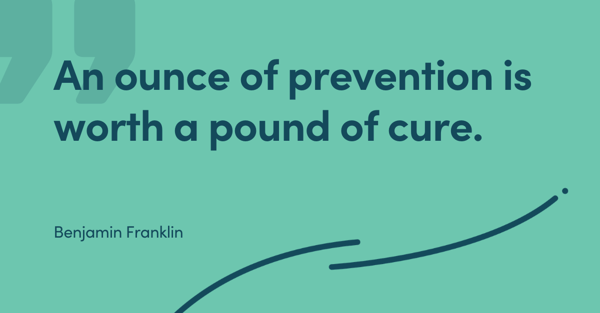In the famous words of Forrest Gump, “it happens”.
With all the things you have to do in Human Resources, the last thing you want is another workplace injury. All those plans you had for the day are now put on hold because you want to make sure you take care of your employee. You want to make sure they know you care.
But, even though you care, you may feel there’s only so much you can do. You can file the paperwork and try to make them feel like your number one concern is getting them the help they need to treat their injury. Unfortunately, it may seem there’s not much else you can do. You end up writing them off for a few days and look at making adjustments to ensure their work is still done. All this leads to more unplanned work.
This is a narrative that is played out repeatedly throughout all HR departments across the nation, and the worst part is, we don’t associate these injuries with cost. We associate them with the hassle and disruption of our busy day.
The Impact of Workplace Injuries
What impact do your workplace injury efforts have on your bottom line? In a previous post, I wrote about the hidden costs of workplace injuries. They don’t hit your financial statements directly — they hide in places where you don’t even realize they are costing you.
You may never think to ask about the impact of workplace injuries. You may think that they have a negative impact on your bottom line, and you probably also think that once they happen, there is nothing you can do about it. What if I told you that’s not true?
“Simply put, if you haven’t been working directly with the healthcare providers that treat your workplace injuries, you've been doing it wrong.”
What if you could reduce the cost of workplace injuries, and while you are at it, throw some accelerant on your prevention efforts? Within this article, I'm going to give you a few ways you can do just that.
Prevention

Though this may seem obvious, it’s worthy of repetition. The least costly injury is the one that doesn’t happen. Secondary to that, small aches and pains are cheaper to treat than full-blown injuries.
The definition of Healthcare is the maintaining and restoration of health by the treatment and prevention of disease.
In our society, we put off small injuries because we assume they aren’t bad enough to go through the hurdles required to receive care.
To us, these minor injuries cost too much money to treat. They may require time off work, and we’re often afraid of finding out what else could be wrong.
In our workplace culture, it may even seem unacceptable to be weak. Especially in a manual labor job. Even acknowledging aches and pains could make an employee seem weak to peers.
So, we focus on restoration and treatment and forgo any prevention and maintenance-based care. This mentality leads to us not taking care of these injuries while they are still minor and least costly to take care of.
Could you imagine treating our cars like that? We change our oil every 3000 miles and rotate our tires every 5000. What if we waited for the engine to blow up before we ever took a look at it? That wouldn't make any sense.
You need to make sure part of your prevention strategy is addressing the aches and pains that we tell ourselves are fine. These are the leading indicators of future injuries — future injuries that are far more costly.
Read more about improving workplace safety through injury mitigation.
Start with First Aid
According to the National Safety Council, overexertion and bodily reaction is the leading nonfatal injury event involving days away from work. The vast majority of these injuries are strains and sprains.
Strains and sprains cause a lot of pain immediately. The injured employee is going to feel uncomfortable, they may feel like they’ve broken something.
When handling an overexertion injury we err on the side of caution, which is always admirable. But, we usually jump straight to an urgent care or emergency room to eliminate possibilities and receive general care for our new injury. Let me repeat that — we seek to eliminate possibilities. This method of addressing our ailments is not maintenance, restoration, treatment, or prevention. I would submit that by definition, this isn’t healthcare either. This is litigation mitigation and what we should be doing is injury mitigation.
Want to learn more about Injury Mitigation? Download our eBook today!
The shortest distance between two points is a straight line. So why not get directly to the care an injury requires to restore prior function?
Many overexertion injuries lead to back pain. To provide some context I want to walk you through an exercise. Now, I am not a healthcare professional, and there is much more to this than I can articulate, but I want to demonstrate a concept. I want you to take your arm and flex your biceps. Show your special someone how strong you are. Nice! You are strong! Now keep flexing and don’t stop. How long can you go? Not very long, right!? Why? Because it hurts. So what do you do to stop the hurting? You stop flexing.
The most common overexertion back pain injuries are just this.
Now, I want you to think of your new workplace injury. You have an employee that has hurt their back. They have small muscles in their back that are flexing and those muscles hurt just like your bicep. The only difference is that your hurt employee doesn't associate that pain with flexing and they don't know how to make it relax. They associate it with a spinal injury. They start thinking they are never going to stand up straight again, they have a bulged disc, and they are going to need surgery. It hurts so bad! This happened to their neighbor too! They are convinced they have a major issue that will require major intervention when all they need to do is get those muscles to relax. Which, in many instances, can be done using first aid.
When you use first aid, you eliminate the need to report the accident to OSHA. You can eliminate a work comp claim. You may eliminate days away, restricted, or transferred. In certain instances, you can get the employee back to full work in the same amount of time it would take the employee to get into an urgent care facility. All this reduces costs immediately!
Keep them at work
As soon as the employee leaves your work site for a workplace injury, the employee enters the traditional healthcare system. Once this happens, while you will continue paying for this treatment, you as the employer no longer have a say in the care performed. In most instances, the individuals administering the care to your employee have never been to your facility. They don’t know the environment in which the employee works and will deliver work restrictions based on generalities for the patient's condition. Again, erring on the side of caution.
The majority of the care the employee will receive is what I mentioned above — litigation mitigation. Especially once they know that the patient is not paying directly for the care.
Healthcare providers are going to eliminate possibilities in order to determine how best to address the injury. All these efforts delay treatment which leads to other unnecessary interventions including imaging, opioid prescriptions, or injections.
Worst yet, these interventions don’t fix the injury, and in many instances, they increase the need for more interventions. In a 2017 study in The Spine Journal, a single patient received 10 different MRI’s, with essentially 10 different interpretations of the imaging. “Zero interpretive findings were reported in all 10 study examinations and only one finding was reported in nine out of 10 study examinations.”
Now let's apply this to your employee with back pain. Your employee may leave work with a back strain, convinced that they will never walk upright again. They go to urgent care and get an order for an MRI to rule things out. They get the MRI scheduled for a few days in the future. In the meantime, they take some opioids for pain. Or better yet, their pain has subsided while waiting for the MRI, but they go through with the MRI anyway. Why? To eliminate possibilities. They receive the MRI, still convinced they have something wrong with their spine. If we throw in a little confirmation bias with this unreliable method of looking at spinal injury, and we have the ingredients for a costly mistake.
Partner with a healthcare provider
Now, you are probably saying to yourself. I am not going to risk trying to take care of a back injury with first aid. I would say to you, “Yes! Please don't!”.
What’s great about OSHA’s definition of first aid is that it doesn’t matter if a healthcare professional provides the care. It is still first aid based upon what was done. This is where the magic happens.
When you can create a direct partnership with a physical therapist, you have a musculoskeletal expert ready to take care of these injuries. Through their expertise, the physical therapist can tell the difference between a strained or flexed muscle, and the possibility of a more serious spinal injury.
This allows you to flip the script on the traditional injury mitigation pathway and go with more efficient methods first. The most important part of this new pathway is that it’s a better method for the injured employee.
Through a direct physical therapist partnership, we can remove the bias of litigation mitigation and get straight to injury mitigation — the best for both employee and employer.
We created Therady for this very reason. There is a better way.





